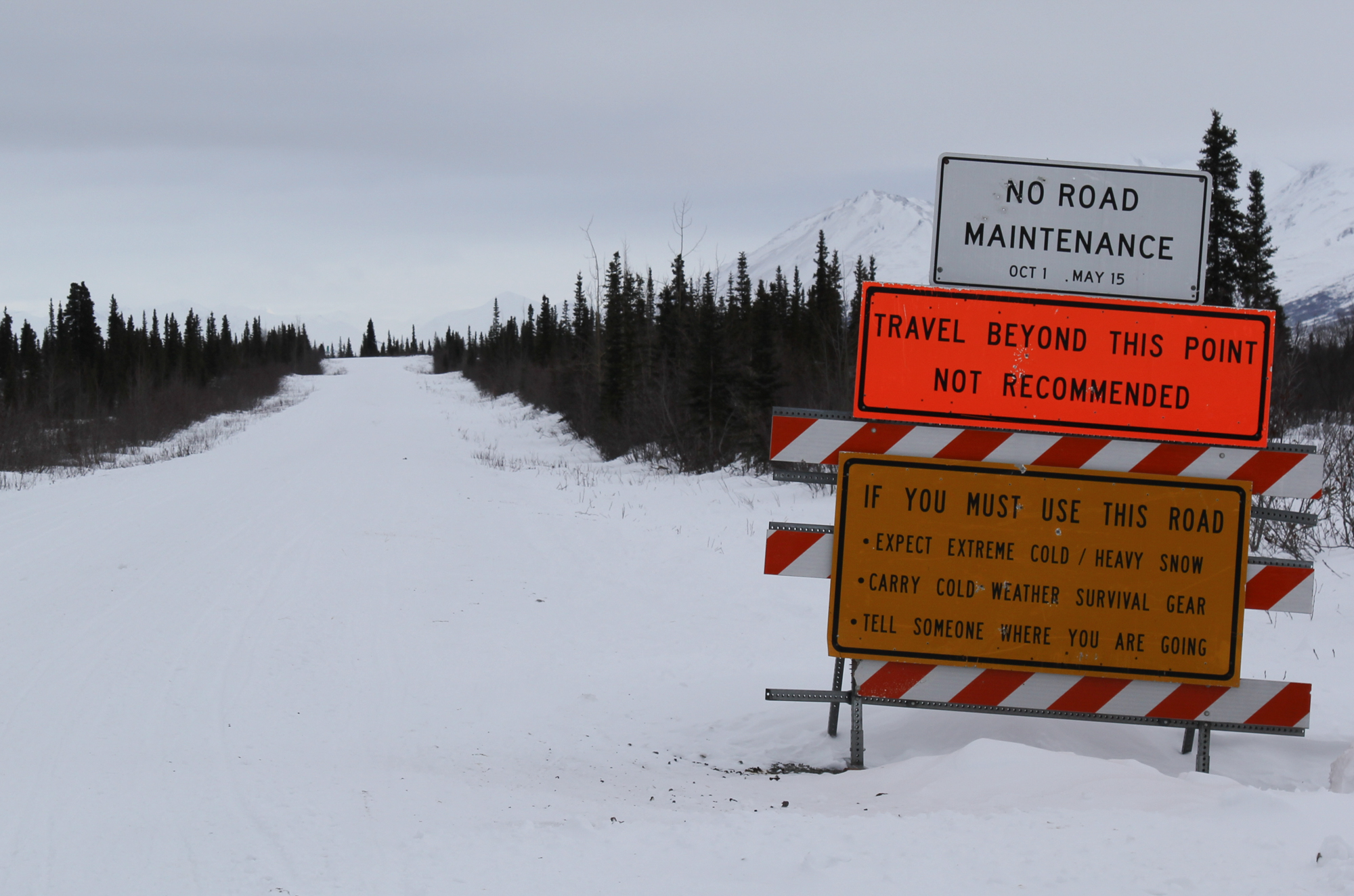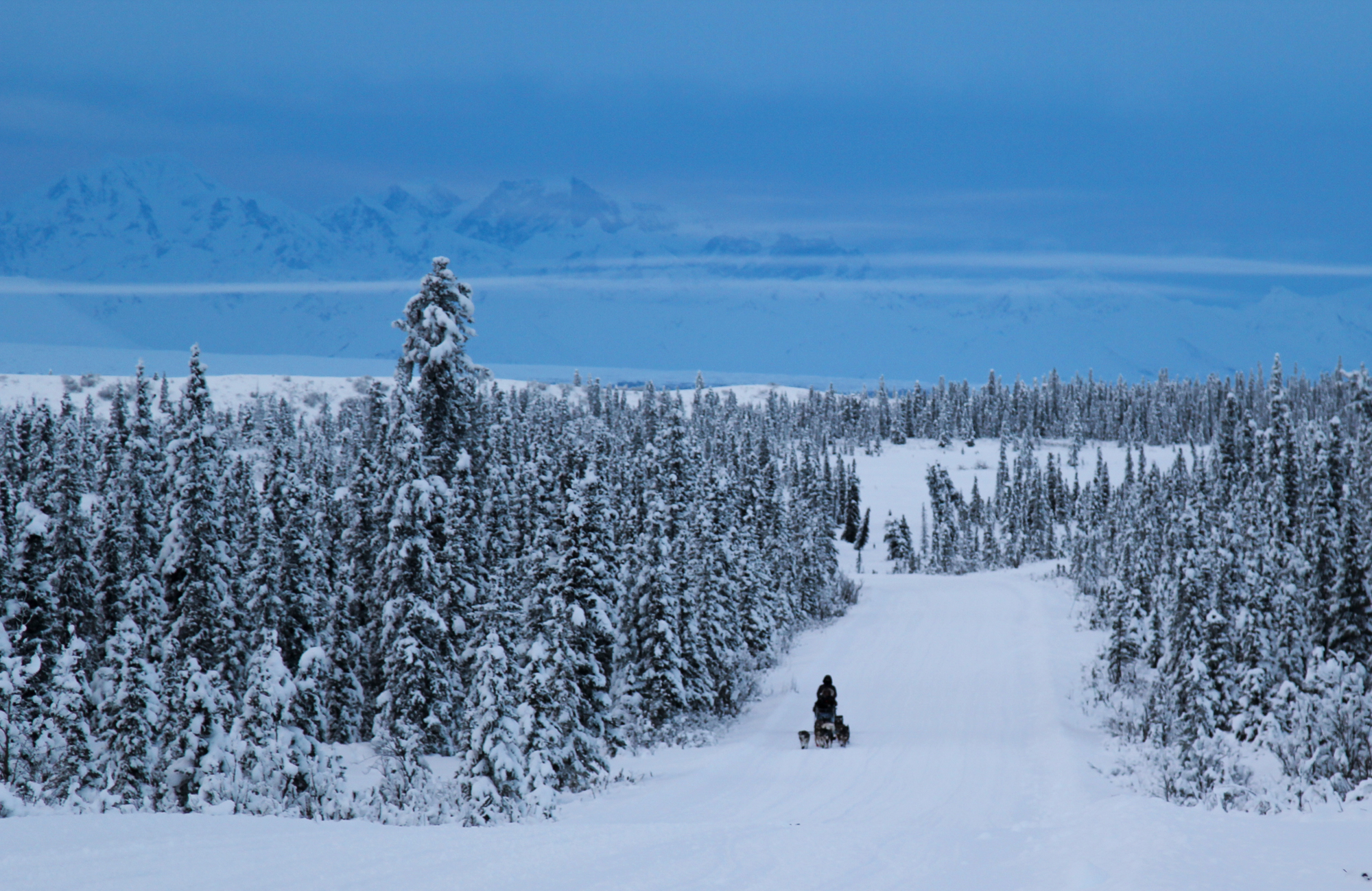Why a remote wilderness lodge in Alaska became a magnet for mushers

Along one of the most remote stretches of the Alaska’s road system is a wilderness lodge that’s become thoroughly popular with elite dog-mushers. The spot offers some of the best winter training for long-distance mushers anywhere in Alaska. The fact that there’s also hot food and cold beer, mushers say, just happens to be a bonus.
For a decade, the Alpine Creek Lodge in the middle of the Denali Highway has built a share of its business around being a convenient way station for mushers training their teams along the 135 miles of nearly un-trafficked winter road.
The Alpine Creek Lodge sits at mile 67 of the highway, equidistant from Paxson to the east and Cantwell to the west. From October to May it is technically closed. Which means that during the winter, people transit primarily with sled-dogs or a snowmachine.

During a recent trip to the Alpine Creek Lodge from the Cantwell side, the local borough had recently groomed the trail, scraping it neatly free of drifts or sizable moguls. Besides some small groups of caribou and a half-dozen moose along the way, the hard-packed trail was clear and fast.
Sensing an opportunity
When Claude Bondy first bought the lodge back in 2008, the main building was just a shell. At the time, Bondy lived on the Kenai Peninsula and would make the 10 hour drive with his wife after work on Friday’s to fit as many renovation projects as they could into each weekend.
“We’re open every day year-round,” Bondy said, sitting midway between a big bellied woodstove and the long tables where guests eat communal meals, a subtle way to unacquainted guests talking with one another like they might in an old roadhouse. On the wall was an impressive array of shimmering pelts: Beaver, marten, fox, all trapped and fleshed by his entrepreneurial 15-year-old son Bob. On a nearby table was a price-list for the hides.
Back when the family was getting the lodge going, there was almost no traffic down the Denali Highway from the Cantwell side during the winter, according to Bondy. A few mushers would use the road for training their dog teams, but they tended to pack in supplies and rough it.
“To me that sounded like an opportunity,” Bondy said.
The family’s business caters primarily to hunters, snowmachiners and well-to-do adventure seekers who can afford lavish wilderness experiences, like a $950-a-day trapping package. In the snowy months, a steady flow mushers pass through, some for a single night, others for weeks at a time.
“One particular year,” Bondy recalled, “50 of 80 mushers in the Iditarod had trained out of here.”
Good relationship with mushers

As a clientele, Bondy says, mushers are relatively self-reliant, hearty and low-maintenance. To other guests, they give the lodge a touch of rugged flavor. Many mushers run businesses of their own showcasing sled-dogs to tourists, and may pass along recommendations for the lodge. Cultivating those relationships, Bondy explained, has been good for the lodge.
There are other accommodations along the Denali Highway, but they close up for parts of the year.
Nathan Krzynski, a handler for Jeff King’s kennel, was finishing up breakfast after a night at the lodge breaking up a long training run.
“This is lap of luxury,” Krzynski said. So far, he’d made four trips to Alpine Creek this winter.
The hot meals, soft bed and hospitality make hours standing on a cold sled a little more bearable. But Krzynski was quick to add that the reason for coming this far is less about creature comforts than how the snowy stretches of highway fit into conditioning a competitive dog team.
“The trail is groomed, the trail is wider,” he said. “The dogs can just get in the zone and work on their endurance.”
One of the distinguishing features of the Iditarod trail is how varied the terrain is. There are highly technical sections that test a mushers ability to hold on to the sled. Then there are long, flat sections, that can be a struggle to mentally endure or merely stay awake on. The highway helps with practicing the latter.
“We are living on what may be the greatest dog-sled training trail in the world, and we don’t have to groom it ourselves,” chuckled Blair Braverman.
Like an artist residency for mushers
Braverman is an Iditarod rookie whose kennel is in Wisconsin, in the north-central U.S. She has lived at Alpine Creek for most of the winter, renting a tiny cabin a stone’s throw from the lodge’s one permanent dog yard. As a relative newcomer to Alaska’s mushing scene, getting the chance to meet and talk with so many of the sports veterans is another major benefit.
“This place is the Chelsea Hotel for long-distance dog-sledders,” Braverman said, referring to a New York City hotel famous for hosting luminaries from the worlds of art and entertainment.
The other perk to posting up at the lodge is that many basic chores are essentially outsourced. Braverman compared it to an artist residency, where food and lodging are provided.
“Those things are taken care of so that you can train obsessively hard on the thing you’re there to do,” she said. “I’m mushing harder than I have in my life, and one of the reasons I can do that is because I know I can come in and I don’t also have to cook.”
Braverman and her partner Quince Mountain were trading off turns driving the dogs on long jaunts with a 300-mile series. After getting harnessed, bootied and clipped onto the gang-line, the dogs were riled up, barking in a canine chorus that kept getting louder.
But when Mountain pulled the snow-hook and bid the team forward, the shrill husky yapping quickly tapered off, replaced by the soft squeak of snow under sled runners and a flutter of paws down a hard packed ribbon of trail. Besides the occasional moose lumbering into the willows, this was all there was for the dogs to concentrate on.
“The longer I’ve been mushing, the more I want to decrease the variables involved in training, so that the training is really just about the dogs getting conditioned to run and getting mentally tough,” Mountain said from the sled, riding the drag-mat to keep the energetic team running evenly at 10 miles-per-hour.
The run lasted 44 miles, followed by a few hours of rest right beside the road, then 44 miles back to the lodge. Repeated over and over, as the young team gets ready to try running all the way to Nome.
Related stories from around the North:
Canada: France’s Thierry Corbarieu wins Yukon Arctic Ultra race in northwestern Canada, CBC News
Finland: Ice fishing World Championships latest in Finnish series of odd sports events, Yle News
Norway: Swedish musher wins Finnmarksløpet, The Independent Barents Observer
United States: Alaska’s Brent Sass wins Yukon Quest sled dog race, CBC News



